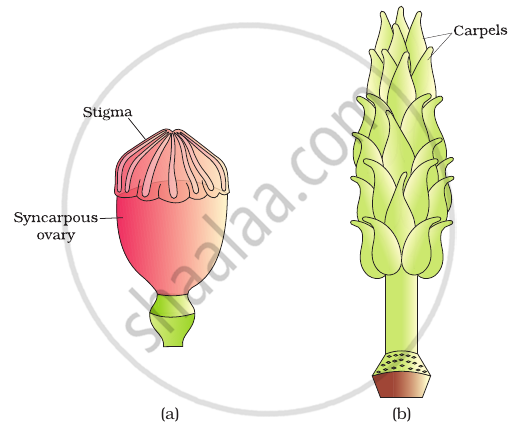Advertisements
Advertisements
प्रश्न
Given below is the diagram of a human ovum surrounded by a few sperms. Study the diagram and answer the following questions :

(a) Which one of the sperms would reach the ovum earlier?
(b) Identify 'D' and 'E'. Mention the role of 'E'.
(c) Mention what helps the entry of sperm into the ovum and write the changes occurring in the ovum during the process.
(d) Name the specific region in the female reproductive system where the event represented in the diagram takes place.
उत्तर
(a) Sperm A will reach the ovum fastest.
(b) D - Cells of the corona radiata
E - Zona pellucida
The zona pellucida layers play several roles such as -
- it supports the communication between oocytes and follicle cells during oogenesis
- it protects the oocytes, eggs, and embryos during development
- it regulates interactions between ovulated eggs and free-swimming sperm during and following fertilization
(c) The anterior portion of the head of the sperm is covered by a cap-like structure called the acrosome. This acrosome is filled with enzymes that help in fertilization of the ovum. As a sperm comes in contact with the zona pellucida layer, it induces changes in the layer and blocks the entry of other sperms. The enzymes of the acrosome help the entry of the sperm into the cytoplasm of the ovum.
(d) This event of fertilization occurs in the ampullary region of the fallopian tube.
APPEARS IN
संबंधित प्रश्न
Answer the following question.
Draw the diagram of a pistil where pollination has successfully occurred. Label the parts involved in reaching the male gametes to its desired destination.
Ovule is ______.
Among the terms listed below, those that of are not technically correct names for a floral whorl are:
- Androecium
- Carpel
- Corolla
- Sepal
The most common type of ovule is ______.
Ovule is straight with funiculus, embryo sac, chalaza, and micropyle lying on one straight line. It is ______.
What is the function of filiform apparatus in an angiospermic embryo sac?
Polygonum type of embryo sac is ______.
Part of the gynoecium which receives the pollen is called ______.
Marginal placentation is present in ______.
Identify the type of carpel with the help of diagrams given below:

